 paved over the dam and made a square? Yup, Amsterdamplatz, or Amstel-dam-square.
paved over the dam and made a square? Yup, Amsterdamplatz, or Amstel-dam-square. Amsterdam Journal
Kate and I caught the three hour train to Amsterdam from the Brussels station. We wanted to arrive as early in the day as possible since most hostels fill up quickly during the summer. Amsterdam probably has more hostels than any other city. Kate had picked up a name of one from another traveler, so we decided to give it a try. We ended up next to the red-light district in a not-so-great hostel called "The Last Watering Hole." I would place the emphasis on hole, though it did have a good bar with live music downstairs at night. Since we were already there, and they had space, we decided to stay. At the beginning of the trip Kate wasn't sure about staying in hostels, but after two weeks she could handle anything.
Amsterdam gets its name from the Amstel river, which it sits upon. More
specifically it gets its name from the dam of the river around which the city
grew up, hence the name Amstel-dam, which became Amsterdam. And when they paved over the dam and made a square? Yup, Amsterdamplatz, or Amstel-dam-square.
paved over the dam and made a square? Yup, Amsterdamplatz, or Amstel-dam-square.
As simple as the name creation process is, Amsterdam is a complicated city to navigate. This is because the canal system imposed a horseshoe shape. So if you walk along one street for thirty minutes, you could end up five minutes from where you started. However people rarely walk here. Much like Copenhagen there are bike lanes all over the city. If you don't have a bike at least there is a decent bus and tram network.
As you walk around town you will notice the unique architecture. Many
of the houses are extremely narrow with gables along the top. When the
municipality decided to levy property taxes, they needed a fair way of assessing
property values. While other cities taxed windows, assuming that the
richer you were the more windows you had (which had the unfortunate side effect
of dark depressing interiors), Amsterdam decided that the width of a house was
an impartial assessment of value. This caused all the new buildings to be
constructed tall, deep, and narrow. However, when it came time to move in,
the furniture could not fit up the stairs. The solution? Fit a
pulley to the top of the gable, hoist 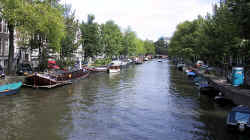 the
furniture into the air, and bring everything in through the windows.
So today the city has distinctive narrow houses with gables along the top.
the
furniture into the air, and bring everything in through the windows.
So today the city has distinctive narrow houses with gables along the top.
Later when the city grew up too fast there was a lack of
affordable housing. Since they had plenty of canal space they offered
people the opportunity to live in houseboats on the water. They offered
electricity, gas, and fresh water hookups to people. This was a great
idea, until the sewage problem reared its proverbial ugly head. Houseboats
of course pumped their waste into the canal... Eventually the problem got
so bad that the city placed a moratorium on new houseboats. So today if
you want to live on the canal you have to find one that is for sale or rent, for
no new houseboats are permitted on the water.
Along almost every street are short metal poles which divide the pedestrian sidewalks from the motorway. For the most part these are maintained by the city, but at some expense. One day the government decided that it would be much more efficient if they simply removed the barriers. The populace was incensed and began to protest. The government soon went back to repairing the barriers.
Amsterdam loves to protest. Another distinctly Amsterdam fixture is the male-only public urinals. These are placed along the canals and are basically a convoluted green metal screen behind which men can pee. This flows into the canal. The structure is topless and bottomless--just the important middle areas are covered--so they clean themselves when it rains. After living with these urinals for years, the women of the city began to shout one day that they wanted public urinals too, equal rights after all. This culminated in a squat down--a band of demonstrators commandeered a bridge over a major canal, hiked up their skirts, and let flow. While it was a successful production in that it received much attention, the women never got their urinals and eventually gave up.
Yes, Amsterdam is a unique place. And I haven't even broached the
subject of the "coffee houses" and 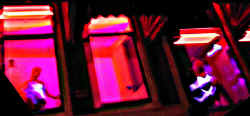 "red-light
district." Probably Amsterdam's defining feature for the rest of the
world is its law that allows you to do whatever you like as long as it does not
hurt others. Interpretation of this law has legalized both drugs and
prostitution. The photo on the left is from the "red-light"
district, which gets its name from the red lights in the windows where the girls
sit and wave to customers. Oddly enough, you are not supposed to take
photos of the windows, even though by doing so you would seem to not be hurting
another person. Anyway, I took this surreptitious photo in low light
without a flash, resulting in the almost-artistic blurred effect.
Coffee houses do serve coffee, though it is not the coffee beans that people are
interested in--they are usually after a more potent drug than
caffeine.
"red-light
district." Probably Amsterdam's defining feature for the rest of the
world is its law that allows you to do whatever you like as long as it does not
hurt others. Interpretation of this law has legalized both drugs and
prostitution. The photo on the left is from the "red-light"
district, which gets its name from the red lights in the windows where the girls
sit and wave to customers. Oddly enough, you are not supposed to take
photos of the windows, even though by doing so you would seem to not be hurting
another person. Anyway, I took this surreptitious photo in low light
without a flash, resulting in the almost-artistic blurred effect.
Coffee houses do serve coffee, though it is not the coffee beans that people are
interested in--they are usually after a more potent drug than
caffeine.
Van Gogh was born in the Netherlands (The proper name of the country is the 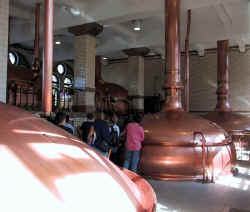 Netherlands,
though everyone also refers to it by Holland, which is really the name of the
largest province). Kate and I went to see a great collection of his art at
the magnificent Van Gogh museum. Definitely make sure to see this
museum if you are in Amsterdam, though there are other great ones to see as
well.
Netherlands,
though everyone also refers to it by Holland, which is really the name of the
largest province). Kate and I went to see a great collection of his art at
the magnificent Van Gogh museum. Definitely make sure to see this
museum if you are in Amsterdam, though there are other great ones to see as
well.
The culturally opposite visit we made was the Heineken brewery.
It is without a doubt the most beer you can get in Amsterdam for two
guilder. There are several tours a day, and each tour breaks into six
groups. The sixth group begins the tour last. The first group
finishes the tour first. However, the free Heineken in the bar at the end
of the trip is as much as you can drink in the allotted time, limited by the
speed of your waiter. The key here is that the drinking ends at the same
time for everyone. You tend to find a higher percentage of Australians in
the first group than in the last. The moral of the story is to arrive well
in  advance
of the scheduled tour to be in the first group. One more tip about the
Heineken tour is to go on your birthday. We saw a celebrator given a
ceramic mug full of beer. Everyone sang happy birthday in their own
language while he drank. Before we started the guide explained that when
the song was finished he had to stop drinking, and the mug would be turned on
top of his head where any remaining contents would spill down. He finished
every drop. In addition to a free mug, he was allowed to visit the bar at
any time without waiting for a waiter for another full mug of beer.
advance
of the scheduled tour to be in the first group. One more tip about the
Heineken tour is to go on your birthday. We saw a celebrator given a
ceramic mug full of beer. Everyone sang happy birthday in their own
language while he drank. Before we started the guide explained that when
the song was finished he had to stop drinking, and the mug would be turned on
top of his head where any remaining contents would spill down. He finished
every drop. In addition to a free mug, he was allowed to visit the bar at
any time without waiting for a waiter for another full mug of beer.
Other travelers had given rave reviews to Mike's Bike Tours, which operate in
both Munich and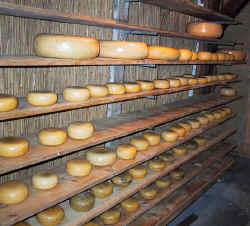 Amsterdam, so we signed up for a tour. That morning we met at the front of
the national museum, hopped on our super-comfortable Schwin street-cruiser bike,
and began to pedal after Brent, our guide. We finally got outside the city
limits where we stopped to see a bona fide windmill.
Amsterdam, so we signed up for a tour. That morning we met at the front of
the national museum, hopped on our super-comfortable Schwin street-cruiser bike,
and began to pedal after Brent, our guide. We finally got outside the city
limits where we stopped to see a bona fide windmill.
Later on we stopped at a dairy farm and cheeserie, or whatever you call a
place that makes cheese. During the warm months they make the cheese
called Gouda. We more than we ever wanted to know about Gouda--it will
keep for ever in the paraffin that encases it, though it will get harder as it
gets older; you can bring this cheese 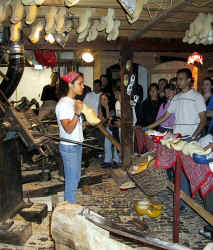 into
the U.S. as long as you haven't cut through the paraffin, and so on.
into
the U.S. as long as you haven't cut through the paraffin, and so on.
When the weather gets colder, they stop making cheese and start making clogs. One piece of wood gets shaved into a single clog.. However, no one wears the famous Dutch footwear anymore. It is good for two occasions--one, for gardening it can't be beat, and two for weddings. Traditional weddings require a fancy pair of clogs for the happy couple. One pair is intended to last you a lifetime...
And then it was time for Kate to leave. We had a sad farewell, and she went back to begin her new job in Boston, while I continue on my own. Well, not quite on my own since I met up with my friend HP later that day, but more on that in a bit.
Traveling with Kate was like a vacation from my trip. With her I didn't meet as many travelers, and I didn't really want to. I was very happy to spend my time with someone I love. When you choose to travel, you choose to leave those people behind. When you see them again, you better understand how much they mean to you. Thanks for sharing my trip with me Kate.
Back to Brussels
My friend HP, whom I had seen in Copenhagen, met me at the train station. He has been working for a law firm in Brussels dealing with monopoly cases for the EU. He was on vacation when Kate and I saw him in Denmark, but he was back in town with a couch for me to crash.As I wrote in the Belgium journal, Brussels sprawls. I had no idea how much it sprawled until I drove around town with HP. This city is best seen with someone who knows it well... Most of it felt like any other overgrown metropolis. I love the statement that no one in Brussels is actually from Brussels.
We headed to a street fair that afternoon. It was a typical fair except for the fare (sorry about the pun)--the food was the only part that felt particularly Belgian. We feasted on grilled herring, steamed mussels, Belgian frites, and beer. HP and I waded through the thick crowd to see some of the rides that lined the streets, several of which were painted in red, white, and blue stars and stripes. It is odd to see motifs which remind you of home when they used to imply that something is exotic.
That evening we went into town for more delicious Belgian ale tasting, after
which we ended up at HP's local pub, Longchamp, a very friendly place where
neighborhood locals gather. We stayed until early in 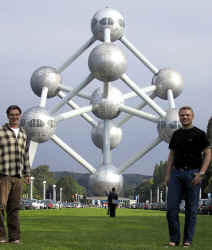 the
morning, though we surprised them the when we showed up at 11 a.m. with another
beer and a sandwich. This sandwich was killer--on a fresh baguette with a
selection of meats and vegetables, but best of all a thick, cheesy (gruyere?),
house-special spread. I still crave this sandwich five months later as I
type this up.
the
morning, though we surprised them the when we showed up at 11 a.m. with another
beer and a sandwich. This sandwich was killer--on a fresh baguette with a
selection of meats and vegetables, but best of all a thick, cheesy (gruyere?),
house-special spread. I still crave this sandwich five months later as I
type this up.
We finished eating and got in the car to head to the Atomium. On the way there we began to eat our chocolate bars we had picked up at a corner store, only to find small white bugs crawling on both of them! Not a very pleasant discovery after a couple of bites, let me tell you.
In 1958 Brussels held a world exposition for which they built a gigantic structure inspired by the birth of the Atomic age. They called this the "Atomium." Kate and I had seen it from a distance, but I had no idea how big it was. An elevator brought us to the first globe and from there we took a combination of escalators and stairs until we finally got to the globe at the top. It felt like something out of a James Bond movie, some sort of space station. If I were an eccentric billionaire I would buy it, convert each globe into a huge room and live there with a butler.
We again ended up at Longchamp for drinks until late. I think I tasted more beers in the six days I spent in Belgium than any other six day period of my life. The pub itself felt more like a family home than a business. They all knew each other and all shared at least one vice.
It was also special to spend time with HP. After twelve years I got to know him better in the four days I spent with him in Copenhagen and Brussels than I had when he spent a year in Augusta, Maine.
The next morning we discovered that my RyanAir flight to Dublin left from Charleroi airport, 40 minutes south of Brussels by car. Luckily HP had one and was happy to drive me so that I could get continue on to...